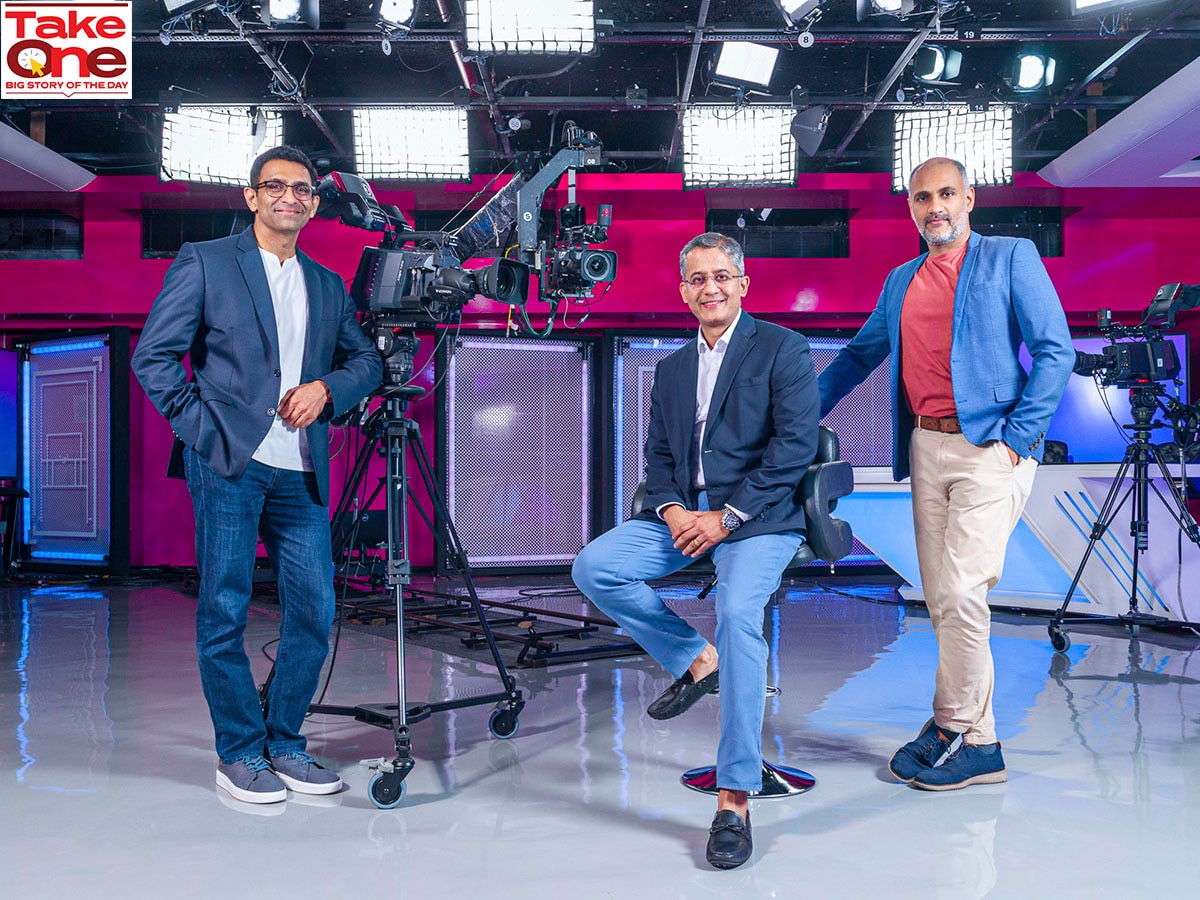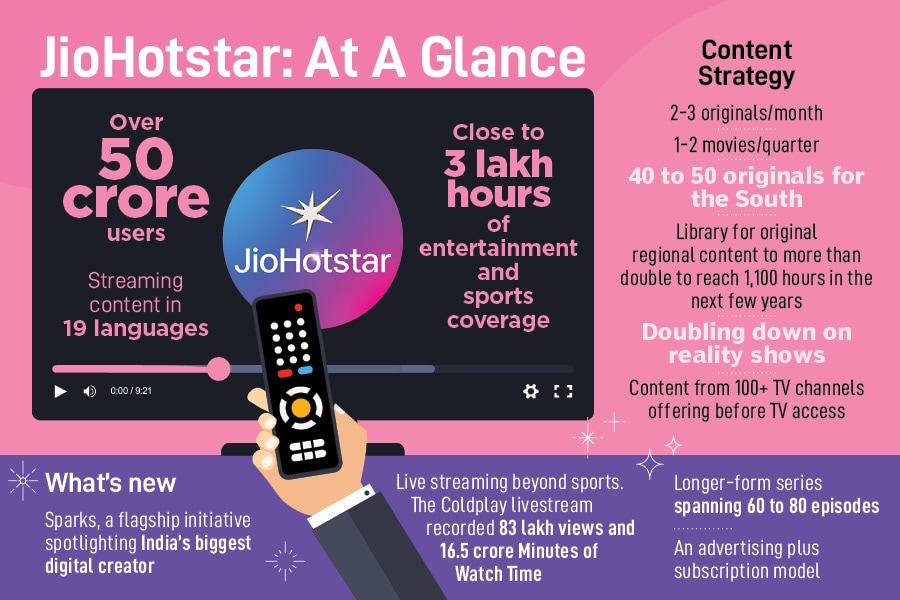 (From left)Kiran Mani, CEO – Digital, Kevin Vaz, CEO Entertainment / Business TV & Digital, Sanjog Gupta, CEO – Sports, JioStar. Photographed at JioStar office, Prabhadevi, Mumbai.
(From left)Kiran Mani, CEO – Digital, Kevin Vaz, CEO Entertainment / Business TV & Digital, Sanjog Gupta, CEO – Sports, JioStar. Photographed at JioStar office, Prabhadevi, Mumbai.
Image: Bajirao Pawar for Forbes India
A day before the much-anticipated launch of JioHotstar—born out of the merger between Hotstar and JioCinema, two of India’s biggest content giants—the 36th floor office of JioStar, a joint venture between Viacom18 and Star India that owns the new platform, appears unusually quiet. Perhaps, it’s the calm before the storm.
As the three CEOs—Kiran Mani, Sanjog Gupta and Kevin Vaz—of this new entity walk into the boardroom, they wear a smile. But Mani, CEO–digital, admits it’s only to mask the nerves. “l’m living on a prayer right now,” he laughs during a freewheeling conversation with Forbes India.
The nerves, perhaps, aren’t out of place given the mammoth task ahead—managing an entity that now has more than 50 crore users, with close to 3 lakh hours of entertainment and sports coverage. And at a time viewing experience is no long limited to the traditional cable TV, but evolving fast into a three-pronged landscape—the digital screen, the smart TV ecosystem with a connected experience, and mobile applications. “With JioHotstar, we now have the opportunity to look at all these three screens as one unified big billion screen audience,” adds Mani.
Alongside, what has changed is the way viewers interact with the content, says Mani further, moving from passive consumption to making distinct choices and interacting with the content. “Viewers earlier used to be lean back, but now it’s lean forward,” says Mani. They want to interact, consume content in bits and pieces and on multiple screens at the same time—so the way you do content has to evolve.” In keeping with the shifting paradigms, JioHotstar’s strategy will be to “simplify the tech and amplify the possibilities”.
JioHotstar, as a combined entity, has access to a library content spanning over 100 channels. It gives them the breadth of options to reach multiple demographics—Disney and Nickelodeon content for kids, while, for the youth, there’s a full range from Bigg Boss to Koffee with Karan, and the originals for the older audience.
But the key moat that the entity is looking to build over the next few years is with longer-form content that spans 60-80 episodes—something that none of its existing competitors have tapped into yet. Most other platforms are banking on their bingeworthy-content, which means, “consumers often have nothing new to watch. This is the gap we’re targeting, by bringing people to the platform every day for new content, instead of just once or twice a month,” says Vaz, CEO-entertainment.
There’s a strategy rethink even for originals where “we want to look at content that targets the entire family and create the binge experience with shows like Criminal Justice, Murder in Mahim among others”, says Vaz. Besides, the platform is hoping to drop 2-3 originals a month in addition to 40-50 titles in Tamil, Telugu, Malayalam and the Southern languages. At present, they programme close to 400-500 hours of original regional content—movies, series or reality shows. “We want to double that to over 1,000 hours. The big advantage we see is that Southern content travels a lot globally,” says Vaz, adding that they are looking to gain further traction by personalising content through AI-driven recommendations and streaming in 19 languages.
The platform has also introduced ‘Sparks’, a flagship initiative spotlighting India’s biggest digital creators through innovative and engaging formats. The platform has onboarded close to 25-30 creators, from Orry to Bhuvan Bam, and they are all doing their own IP shows on the platform. Sparks will be a part of the JioHotstar application, but displaying a very different format of content.
Also read: Explained: What does the Reliance-Disney binding agreement mean for the M&E industry?
Live Sports and Beyond
A key viewing on the JioHotstar platform is live sports, with Disney owning the rights of ICC’s matches till 2027, while JioCinema winning the streaming rights of the IPL till 2027, outbidding its current partner, Disney.
“We are trying to level up that sense of community and millions of people watching together, while offering uniquely designed highly personalised experiences,” says Gupta, CEO-sports, JioStar. The platform will be home to premier tournaments like ICC events, IPL, and WPL, while also spotlighting grassroots cricket with the Indian Street Premier League and pathway events from BCCI, ICC, and state associations. Beyond cricket, it will also stream global sporting excellence with the Premier League and Wimbledon as well as domestic leagues like Pro Kabaddi and ISL.
With live sports, the idea is to deliver a viewing experience that is uniquely developed for individual preferences—from camera angles to preference of commentary language. “Ideally, if one is a Virat Kohli fan, you should be able to watch an RCB game during the IPL or an India match, in a certain way. So, this is the big challenge that the product team has taken on. We are looking to unveil this over the next few months—to my mind, this will be most advanced, world-class and also uniquely designed sports experience offered anywhere,” says Gupta. The elevated streaming experience will include featuring ultra-HD 4K streaming, AI-powered insights, real-time stats overlays, multi-angle viewing and range of ‘culture’ and ‘special interest’ feeds.
The JioHotstar team also wants to take the live streaming experience beyond sports, and the Coldplay concert at the Narendra Modi Stadium in Ahmedabad on January 26 was a start. With its success—83 lakh views and 16.5 crore minutes of watch time—the plan is to look at streaming many more events and music concerts.
How did they convince the team? “We sold them a dream,” says Gupta. Initially, when they approached Coldplay, “the first reaction, was an absolute no”, he recalls. “We told them this would be the biggest concert this country has ever seen, both in terms of the people at the stadium, but more importantly, the people outside the stadium, sharing this one moment which we believed could be culture defining,” adds Gupta. After a lot of convincing, they finally agreed only on January 8—which meant 18 days to set up the tech backend, and 10 days to monetise.
There was significant investment that went into the set-up—with close to 42 cameras across the entire stadium. “It is one thing to live stream sports, which is primarily all about visual appeal. But to live stream a concert, also means there is visual and audio appeal that is needed, which is technologically completely different,” explains Mani. The team, shot on January 25 as well, which was a rehearsal to livestream the concert the next day. “It was truly, an adventure of a lifetime for us as well,” laughs Gupta.

Ad-Subscription Driven Streaming
So far, the perspective has been that JioCinema was an Advertising Video On Demand (AVOD) platform and Hotstar a Subscription Video On Demand (SVOD) platform, but Mani says, “The reality is somewhere in between—a combination of AVOD and SVOD. Now, we are opening up access for everyone to watch everything.” Keeping a consumer-first approach in mind, the platform will now allow a sampling window of a couple of hours every month for users to come experience content on the platform. The pricing model for subscribers remains the same as that for Hotstar—starting at Rs 499 annually.
As for advertisers, entry point for small and medium businesses are priced at Rs 20,000 per package—again making it a lot more accessible. However, so far ads would be placed at random spots, during a film or a television series—which interrupted a consumer’s viewing experience.
The plan is to make that a lot more personalised as well. For instance, during the Coldplay concert live stream, Vaz says, “We managed to get the right advertisers, and the ad placement was in a way that it didn’t kill the experience.” Oreo, for instance, paid a significant premium, only to be associated with Coldplay’s song ‘Yellow’—this allowed for a much better brand recall. In fact, advertising during live sports is seen to be the norm. Gupta explains, “People often use that time to take a break, and catch up on news headlines or take their washroom breaks.”
Nielsen, a global leader in audience measurement, data, and analytics, has collaborated with the platform ahead of the Indian Premier League (IPL) 2025, to measure the effectiveness of advertiser campaigns on JioHotstar properties, leveraging its in-depth expertise in audience measurement and first-party data. “With this, we aim to bring more transparency and accountability to digital ad measurement. Together, we are shaping the future of India’s rapidly evolving media landscape, helping advertisers to make more informed and data-driven decisions that should ultimately drive better outcomes in a dynamic digital environment,” says Arnaud Frade, President, (Commercial), Asia, Nielsen.
It is necessary to enhance the entire experience—and make access, sustainable and affordable for all stakeholders involved—users and advertisers. Hence, the only sustainable way to go about this is advertising plus subscription. “The idea is, loyalty leads to subscriptions, not the other way around,” he says.
Putting all these machines together, comes distribution. Here, partnerships with telco operators will continue to remain at the heart of distribution for JioHotstar, just as it was earlier with Disney+ Hostar and JioCinema. “They help us make content affordable and accessible to a billion screens,” says Mani.
India is a highly fragmented market, where there are mobile phones ranging from 2 inches to 200 inches. “We live stream cricket on Jio Bharat phones also, which are Rs2,500, and you can have a full viewing experience there,” says Mani. Every single device has a different resolution, basis the data it uses, that gets intuitively streamed. “Our tech team runs 1,600 different cohorts of device user behaviour in order to bring a cricket match live. Access is not an easy technology problem to solve,” he adds.
JioHotstar has its mind set on building a legacy and taking content to a billion screens. But with the existing competition with the likes of large players such as Netflix and Amazon Prime Video, it is going to be no easy feat. But the leadership team is confident, and as Vaz says, “For everything that we do, we want it to be world class.”
